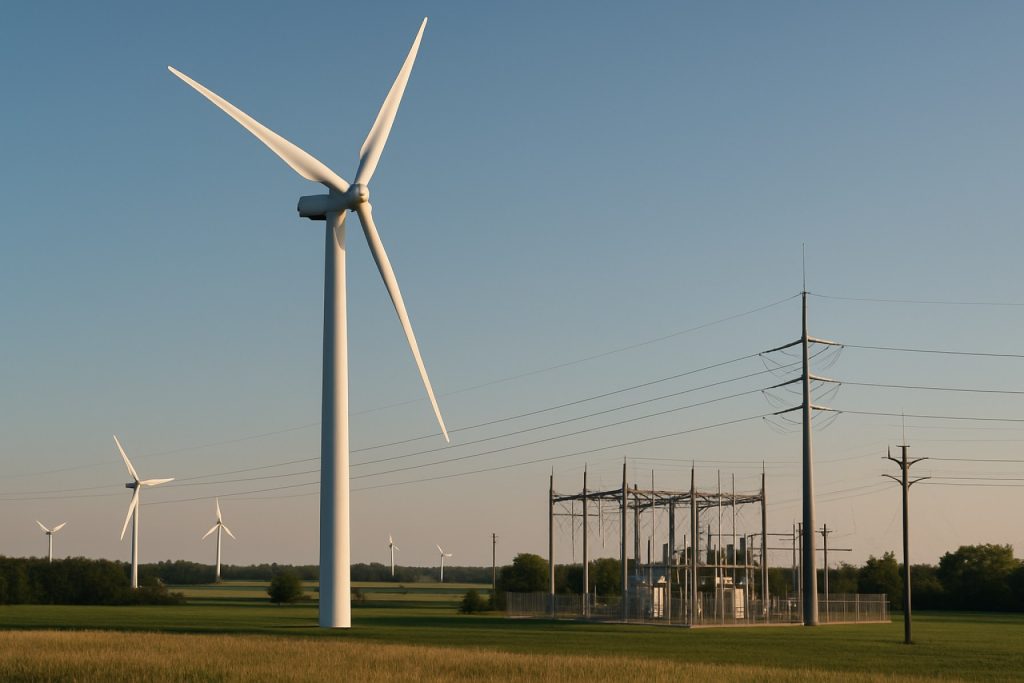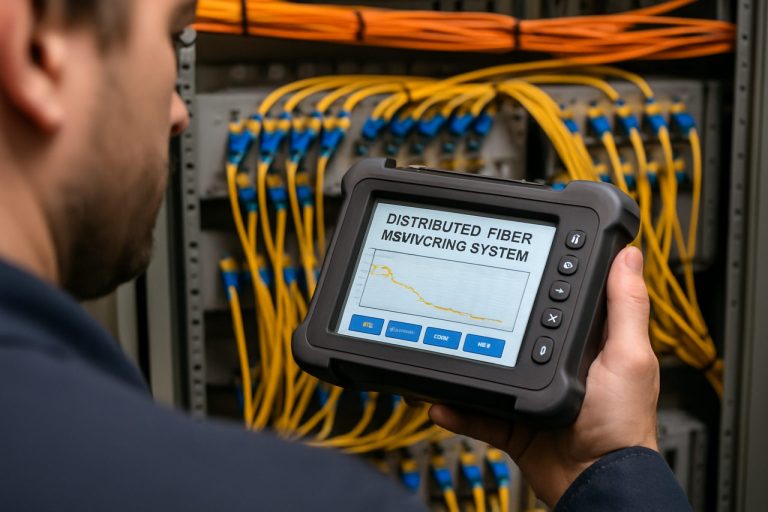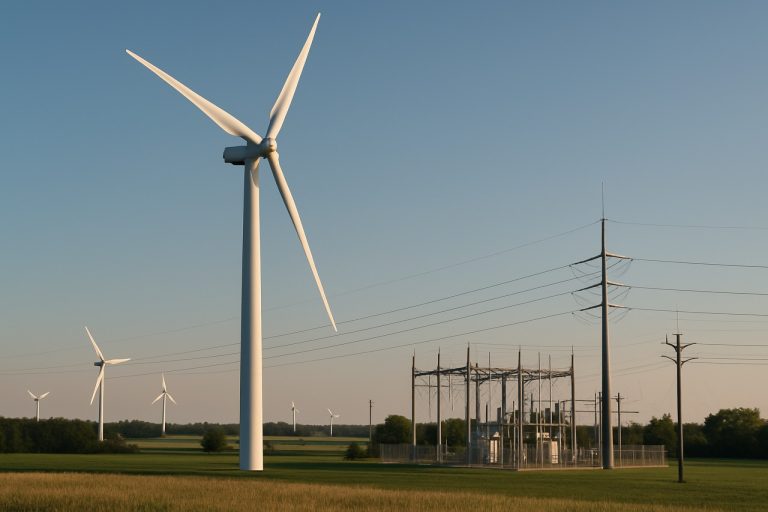
Distributed Wind Energy Systems Market Report 2025: In-Depth Analysis of Growth Drivers, Technology Innovations, and Regional Opportunities. Explore Market Forecasts, Competitive Dynamics, and Key Challenges Shaping the Industry.
- Executive Summary & Market Overview
- Key Technology Trends in Distributed Wind Energy Systems
- Competitive Landscape and Leading Players
- Market Growth Forecasts (2025–2030): CAGR, Revenue, and Volume Analysis
- Regional Market Analysis: North America, Europe, Asia-Pacific, and Rest of World
- Future Outlook: Emerging Applications and Policy Impacts
- Challenges and Opportunities: Regulatory, Technical, and Market Entry Barriers
- Sources & References
Executive Summary & Market Overview
Distributed wind energy systems refer to wind turbines installed at or near the point of use, such as homes, farms, businesses, and communities, rather than centralized, utility-scale wind farms. These systems are typically connected either behind the meter or directly to local distribution networks, enabling on-site electricity generation and consumption. The global distributed wind energy market is poised for steady growth in 2025, driven by increasing demand for decentralized renewable energy, supportive policy frameworks, and advancements in small and medium wind turbine technologies.
According to the International Energy Agency, distributed wind capacity additions are expected to accelerate in 2025, particularly in regions with strong policy incentives and grid modernization efforts. The United States, China, and several European countries remain at the forefront, with the U.S. Department of Energy reporting over 1 GW of cumulative distributed wind capacity installed as of 2023, and annual installations projected to rise as state-level net metering and community wind programs expand (U.S. Department of Energy).
Market drivers in 2025 include heightened energy security concerns, rising electricity prices, and the need for grid resilience in the face of climate-related disruptions. Distributed wind systems offer unique value by reducing transmission losses, supporting rural electrification, and enabling energy independence for remote or off-grid locations. Technological improvements—such as quieter, more efficient turbines and digital monitoring platforms—are lowering barriers to adoption and reducing lifecycle costs (Wood Mackenzie).
However, the market faces challenges, including permitting complexities, variable wind resources at distributed sites, and competition from rapidly falling solar PV costs. Policy stability and streamlined interconnection processes remain critical for sustained growth. In 2025, industry stakeholders are expected to focus on hybrid systems (wind-plus-solar-plus-storage), community ownership models, and innovative financing mechanisms to unlock new market segments (National Renewable Energy Laboratory).
In summary, the distributed wind energy systems market in 2025 is characterized by moderate but resilient growth, technological innovation, and evolving business models. Its role in the broader energy transition is increasingly recognized, particularly as distributed generation becomes central to decarbonization and energy democratization strategies worldwide.
Key Technology Trends in Distributed Wind Energy Systems
Distributed wind energy systems refer to wind turbines installed at or near the point of use, such as homes, businesses, farms, or remote communities, rather than centralized wind farms. As the global energy landscape shifts toward decentralization and decarbonization, distributed wind is gaining traction due to its potential for local energy resilience, grid support, and emissions reduction. In 2025, several key technology trends are shaping the evolution and adoption of distributed wind energy systems.
- Advanced Turbine Designs: Manufacturers are introducing smaller, quieter, and more efficient turbines tailored for distributed applications. Innovations include variable-speed generators, direct-drive systems, and advanced blade aerodynamics, which improve performance in low and variable wind conditions. Companies such as ENERCON and National Renewable Energy Laboratory (NREL) are at the forefront of these developments.
- Integration with Smart Grids and Energy Storage: Distributed wind systems are increasingly being paired with battery storage and integrated into smart grids. This enables better management of intermittent generation, demand response, and local grid stability. The deployment of digital monitoring and control platforms, as highlighted by International Energy Agency (IEA), is facilitating real-time optimization and remote diagnostics.
- Hybrid Renewable Systems: There is a growing trend toward hybrid systems that combine distributed wind with solar PV and other renewables. These systems offer greater reliability and smoother power output, making them attractive for off-grid and microgrid applications. According to Wood Mackenzie, hybridization is expected to accelerate in rural and island communities.
- Modular and Plug-and-Play Solutions: The market is seeing the emergence of modular, easy-to-install wind systems designed for rapid deployment and minimal site preparation. These solutions lower installation costs and make distributed wind accessible to a broader range of users, as reported by NREL.
- Digitalization and Predictive Maintenance: The adoption of IoT sensors, machine learning, and predictive analytics is enhancing the reliability and lifespan of distributed wind assets. Operators can now anticipate maintenance needs, reduce downtime, and optimize energy output, as detailed by BloombergNEF.
These technology trends are expected to drive down costs, improve performance, and expand the market reach of distributed wind energy systems in 2025 and beyond.
Competitive Landscape and Leading Players
The competitive landscape of the distributed wind energy systems market in 2025 is characterized by a mix of established turbine manufacturers, innovative startups, and regional players, each vying for market share in a sector driven by the global push for decentralized renewable energy solutions. The market is moderately fragmented, with no single company dominating globally, but several firms hold significant regional influence due to their technological expertise, local partnerships, and tailored product offerings.
Leading players in the distributed wind sector include Enercon, Nordex, and Vergnet, all of which have leveraged their experience in utility-scale wind to develop smaller-scale turbines suitable for distributed applications. National Renewable Energy Laboratory (NREL) data highlights that these companies have focused on modular, easy-to-install systems that appeal to commercial, agricultural, and community users seeking energy independence and resilience.
In North America, Northern Power Systems and Bergey Windpower are prominent, with a strong track record in supplying turbines for rural electrification and off-grid applications. Their competitive edge lies in robust after-sales support and a portfolio of turbines optimized for lower wind speeds, which are common in distributed settings. Meanwhile, European firms such as Eocycle Technologies and Evwind have expanded their reach through strategic partnerships and by addressing the needs of small businesses and municipalities.
- Product Innovation: Companies are investing in advanced control systems, remote monitoring, and hybrid integration (with solar and storage) to differentiate their offerings. For example, Eocycle Technologies has introduced direct-drive turbines with lower maintenance requirements, appealing to cost-sensitive customers.
- Regional Focus: Market leaders tailor their products to local regulatory environments and grid requirements. In Asia-Pacific, local manufacturers are gaining ground by offering cost-competitive solutions and leveraging government incentives for rural electrification.
- Strategic Alliances: Collaborations between turbine manufacturers, project developers, and financing institutions are increasingly common, enabling broader market penetration and reducing project risk for end-users.
Overall, the distributed wind energy systems market in 2025 is marked by dynamic competition, with leading players differentiating through technology, service, and regional adaptation. The sector’s growth is expected to attract new entrants, further intensifying competition and accelerating innovation.
Market Growth Forecasts (2025–2030): CAGR, Revenue, and Volume Analysis
The distributed wind energy systems market is poised for robust growth between 2025 and 2030, driven by increasing demand for decentralized renewable energy solutions, supportive policy frameworks, and technological advancements. According to projections by MarketsandMarkets, the global distributed wind market is expected to register a compound annual growth rate (CAGR) of approximately 8–10% during this period. This growth is underpinned by rising investments in small- and medium-scale wind projects, particularly in rural and off-grid areas where grid extension is economically unfeasible.
Revenue from distributed wind energy systems is forecasted to reach between USD 2.5 billion and USD 3.2 billion by 2030, up from an estimated USD 1.6 billion in 2025. This revenue growth is attributed to both the increasing number of installations and the scaling up of project sizes, as commercial and industrial users seek to reduce energy costs and carbon footprints. The International Energy Agency (IEA) highlights that distributed wind is gaining traction in North America, Europe, and parts of Asia-Pacific, with China and the United States leading in new capacity additions.
In terms of volume, the global installed capacity of distributed wind turbines is projected to grow from approximately 1.2 GW in 2025 to over 2 GW by 2030. The U.S. Department of Energy reports that the U.S. alone could add over 200 MW of distributed wind capacity annually, driven by state-level incentives and net metering policies. Europe is also expected to see significant volume growth, particularly in countries with ambitious renewable energy targets and supportive feed-in tariffs.
- Key growth drivers: Declining turbine costs, streamlined permitting processes, and integration with energy storage and smart grid technologies.
- Market segmentation: The commercial and industrial segments are anticipated to outpace residential installations, accounting for over 60% of new capacity additions by 2030.
- Regional outlook: Asia-Pacific is forecasted to exhibit the highest CAGR, while North America and Europe will maintain steady growth due to mature markets and policy support.
Overall, the distributed wind energy systems market is set for sustained expansion through 2030, with strong revenue and volume growth reflecting the sector’s increasing role in the global energy transition.
Regional Market Analysis: North America, Europe, Asia-Pacific, and Rest of World
The global distributed wind energy systems market exhibits distinct regional dynamics shaped by policy frameworks, grid infrastructure, and renewable energy targets. In 2025, North America, Europe, Asia-Pacific, and the Rest of the World (RoW) each present unique growth trajectories and challenges for distributed wind deployment.
North America remains a leading market, driven by the United States’ robust rural electrification initiatives and state-level incentives. The U.S. Department of Energy reports that distributed wind capacity surpassed 1 GW by 2023, with continued growth expected as net metering policies and community wind projects expand (U.S. Department of Energy). Canada is also advancing, particularly in remote and indigenous communities seeking off-grid solutions. However, permitting complexities and grid interconnection costs remain barriers.
Europe benefits from ambitious decarbonization targets and supportive regulatory frameworks. Countries such as Denmark, Germany, and the United Kingdom are at the forefront, leveraging feed-in tariffs and streamlined permitting for small and medium wind installations. The European Commission’s REPowerEU plan further accelerates distributed wind adoption as part of energy security and climate goals (European Commission). The market is characterized by a mature supply chain and strong integration with other distributed energy resources, though land use constraints and public acceptance issues persist in densely populated regions.
- Asia-Pacific is witnessing rapid expansion, led by China and India. China’s rural electrification programs and local manufacturing capacity have made it the largest market for small wind turbines, with over 500 MW installed by 2024 (International Energy Agency). India’s government incentives and microgrid initiatives are fostering adoption in off-grid and agricultural sectors. Southeast Asian nations are also exploring distributed wind to complement solar in hybrid systems, though financing and technical expertise remain challenges.
- Rest of the World encompasses diverse markets, including Latin America, Africa, and the Middle East. In these regions, distributed wind is primarily deployed for rural electrification and water pumping. Countries like Brazil and South Africa are piloting community wind projects, supported by international development agencies (World Bank). However, market growth is constrained by limited policy support, high upfront costs, and underdeveloped supply chains.
Overall, while North America and Europe lead in policy and technology maturity, Asia-Pacific is emerging as a volume driver, and RoW markets offer long-term potential as enabling conditions improve. Regional disparities in incentives, grid access, and local manufacturing will continue to shape the distributed wind energy landscape in 2025.
Future Outlook: Emerging Applications and Policy Impacts
Looking ahead to 2025, distributed wind energy systems are poised for significant growth, driven by technological advancements, evolving policy frameworks, and expanding application scenarios. Distributed wind—defined as wind turbines installed at or near the point of use, such as homes, businesses, farms, and remote communities—offers unique advantages in energy resilience, grid support, and decarbonization efforts.
Emerging applications are broadening the market for distributed wind. In rural and agricultural settings, distributed wind is increasingly being integrated with microgrids and hybrid renewable systems, providing reliable power for irrigation, processing, and storage. The commercial and industrial sectors are also adopting distributed wind to offset energy costs and meet sustainability targets, particularly as corporate renewable energy procurement accelerates. Notably, the electrification of transportation and the proliferation of electric vehicle charging infrastructure present new opportunities for distributed wind to supply localized, clean power directly to charging stations, reducing grid congestion and transmission losses.
Policy impacts will be pivotal in shaping the distributed wind landscape in 2025. In the United States, the extension and expansion of federal incentives—such as the Investment Tax Credit (ITC) and production-based incentives—are expected to stimulate new installations, especially for small and community-scale projects. State-level renewable portfolio standards and net metering policies are also being refined to better accommodate distributed wind, enhancing project economics and grid integration. In Europe, the European Union’s Fit for 55 package and revised Renewable Energy Directive are encouraging member states to streamline permitting and grid access for distributed renewables, including wind, which is anticipated to accelerate deployment in both urban and rural areas.
- Technological innovation is reducing the cost and complexity of distributed wind systems. Advances in turbine design, digital controls, and predictive maintenance are improving performance and reliability, making distributed wind more accessible to a wider range of users.
- Hybridization with solar and storage is becoming a standard approach, enabling distributed wind to provide firm, dispatchable power and participate in demand response and ancillary services markets.
- Policy harmonization and the removal of regulatory barriers are expected to unlock new markets, particularly in regions with high energy costs or weak grid infrastructure.
According to the National Renewable Energy Laboratory, the U.S. distributed wind market could see annual capacity additions double by 2025 if supportive policies and streamlined permitting processes are implemented. Similarly, the International Energy Agency projects that distributed wind will play a critical role in achieving net-zero targets, especially in decentralized energy systems and emerging economies.
Challenges and Opportunities: Regulatory, Technical, and Market Entry Barriers
Distributed wind energy systems—small- to medium-scale wind turbines installed at or near the point of use—are gaining traction as a decentralized solution for clean energy generation. However, their broader adoption in 2025 faces a complex landscape of regulatory, technical, and market entry barriers, alongside emerging opportunities.
Regulatory Challenges and Opportunities
- Zoning and Permitting: Local zoning laws and permitting processes remain inconsistent and often cumbersome, varying significantly across municipalities. This patchwork can delay projects and increase costs. However, some regions are streamlining permitting for distributed renewables, presenting opportunities for faster deployment (U.S. Department of Energy).
- Interconnection Standards: Utilities may impose complex interconnection requirements, particularly for grid-tied systems, leading to technical and administrative hurdles. Efforts to standardize and simplify these processes, such as updated IEEE 1547 standards, are gradually reducing these barriers (IEEE).
- Incentives and Policy Support: While some regions offer tax credits or feed-in tariffs, inconsistent policy frameworks can undermine investor confidence. The expansion of state-level renewable portfolio standards and federal incentives in the U.S. and Europe is expected to create new opportunities in 2025 (International Energy Agency).
Technical Barriers and Innovations
- Grid Integration: Integrating distributed wind into existing grids poses challenges related to voltage regulation, frequency stability, and bidirectional power flows. Advances in smart inverters and microgrid technologies are helping to address these issues (National Renewable Energy Laboratory).
- Resource Assessment: Accurate wind resource assessment at the micro-siting level remains a technical hurdle, especially in complex terrains. The adoption of advanced modeling tools and remote sensing technologies is improving project feasibility and performance predictions (Wood Mackenzie).
Market Entry Barriers and Growth Prospects
- Economies of Scale: Distributed wind systems often face higher per-kilowatt costs compared to utility-scale projects, limiting competitiveness. However, falling turbine prices and innovative financing models are narrowing this gap (BloombergNEF).
- Awareness and Acceptance: Limited public awareness and concerns about noise or aesthetics can hinder adoption. Targeted outreach and community engagement are proving effective in overcoming these obstacles (American Clean Power Association).
In summary, while distributed wind energy systems in 2025 face notable regulatory, technical, and market entry barriers, ongoing policy reforms, technological advancements, and innovative business models are unlocking new opportunities for growth and wider adoption.



